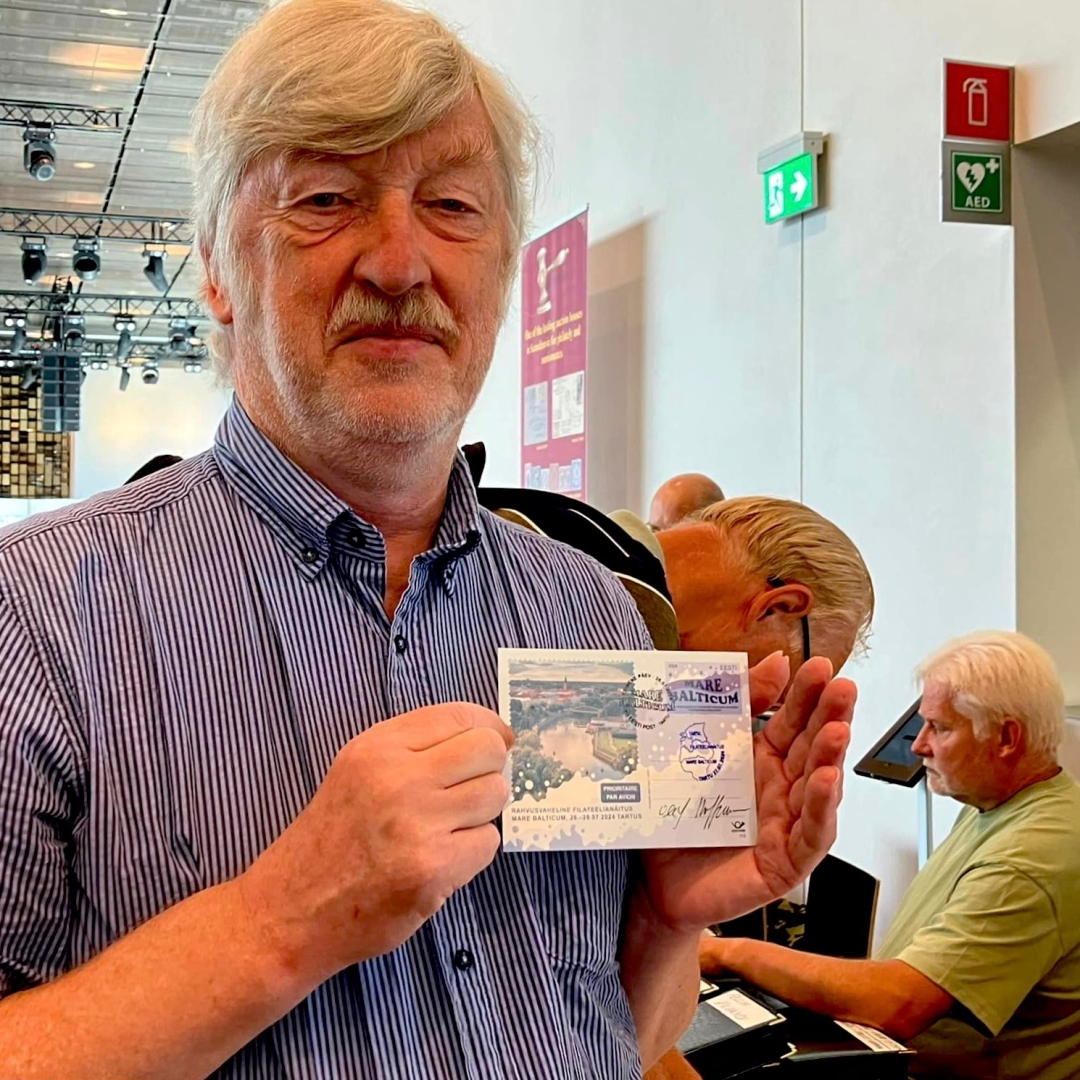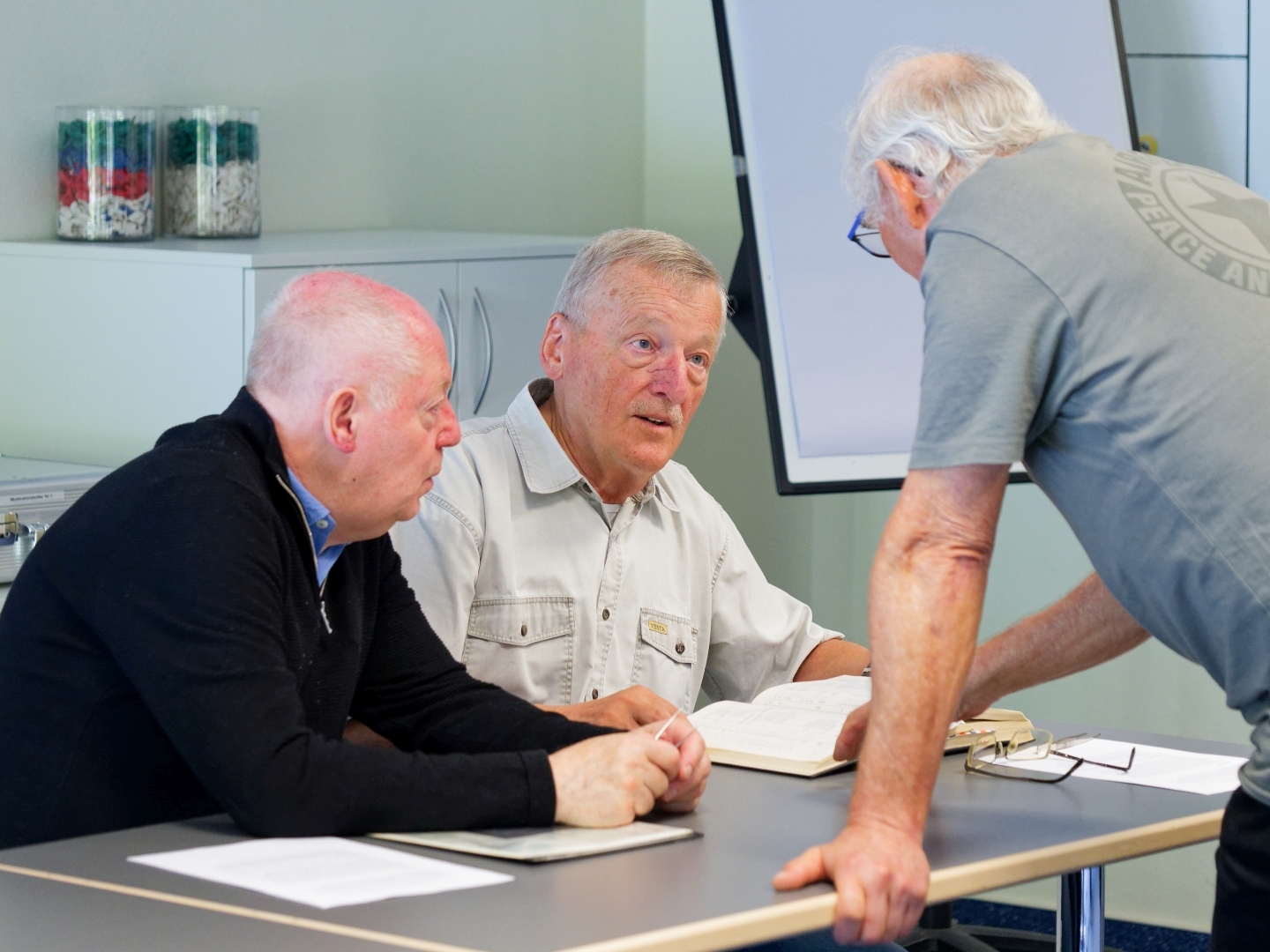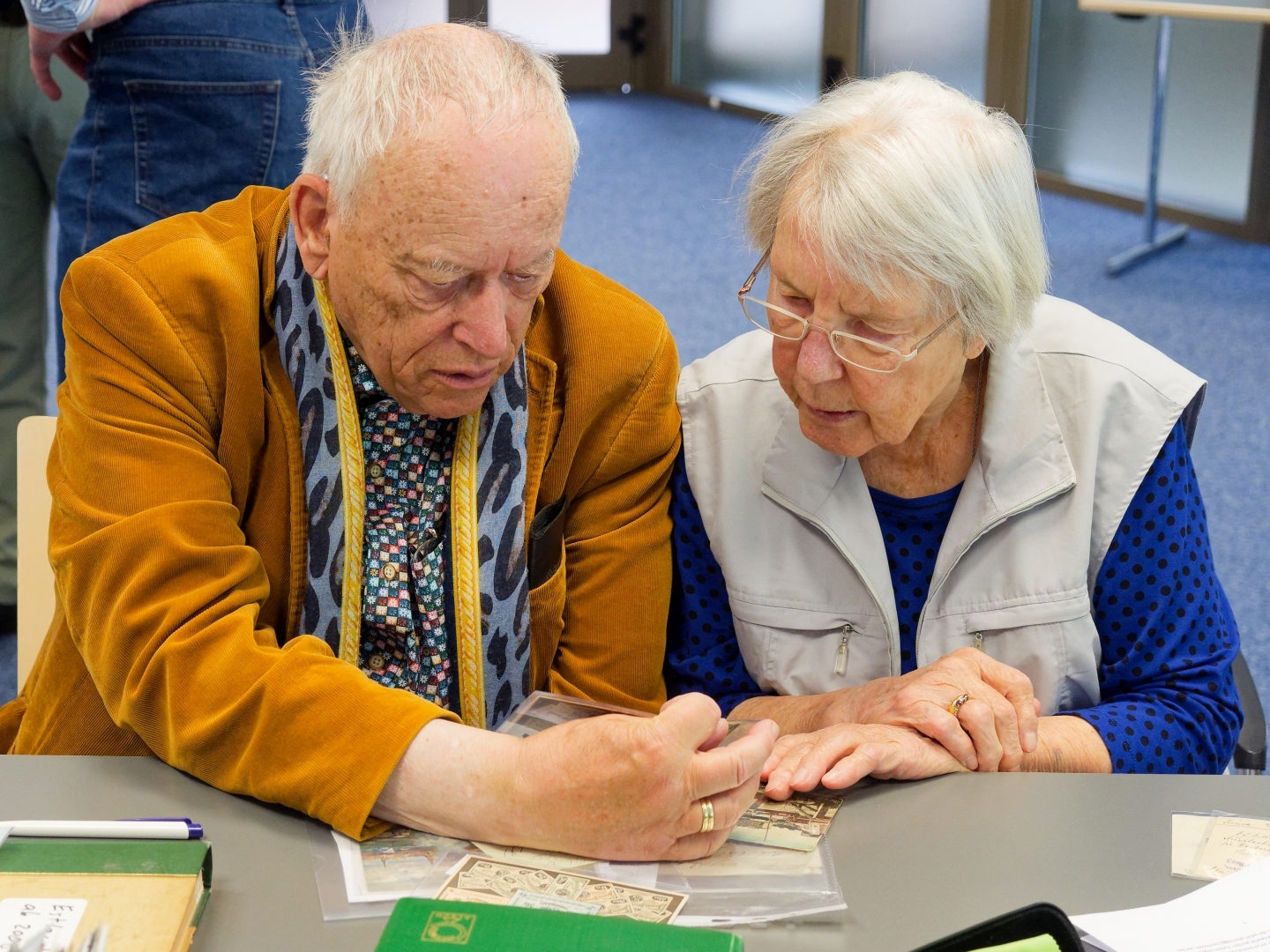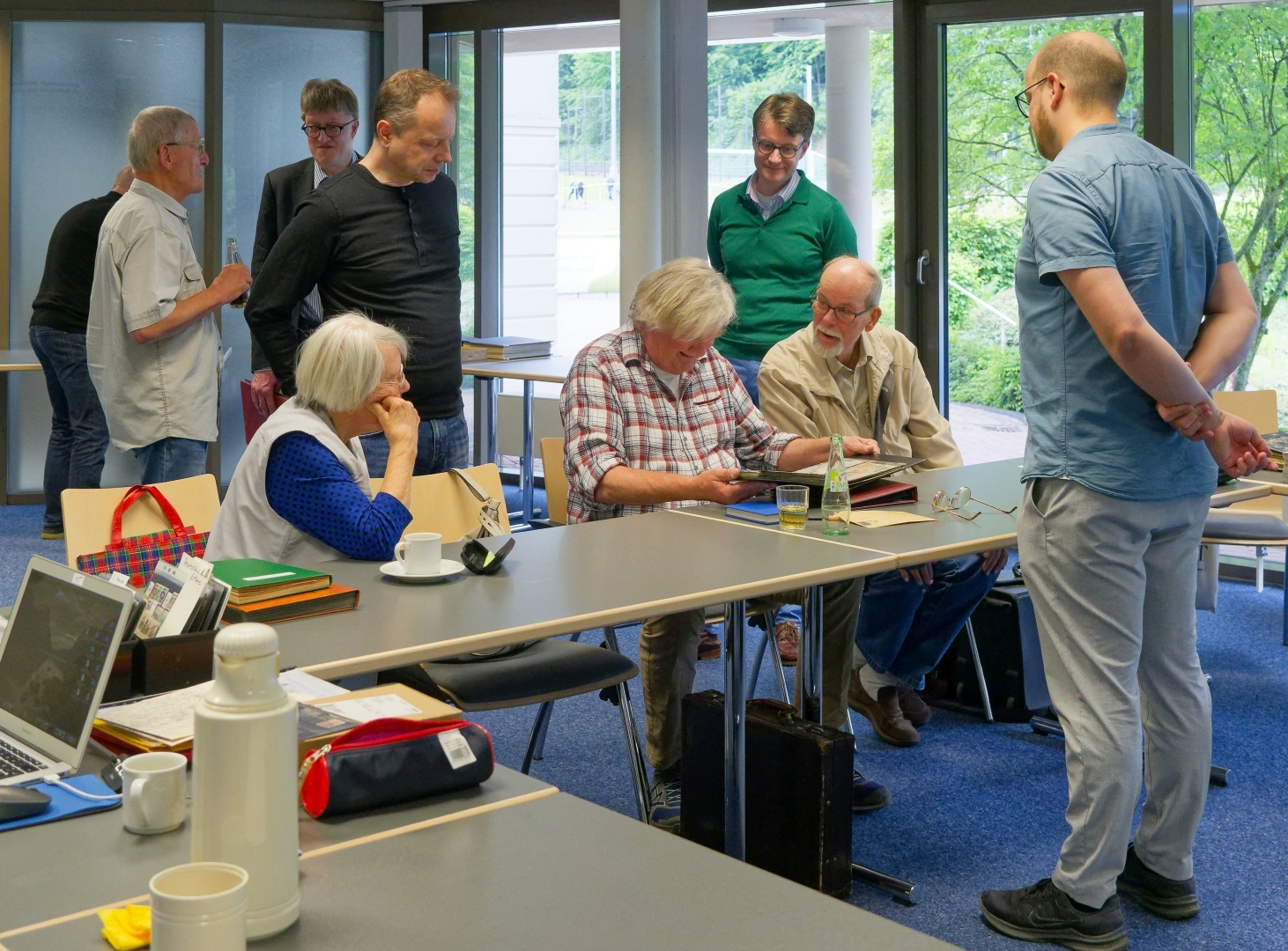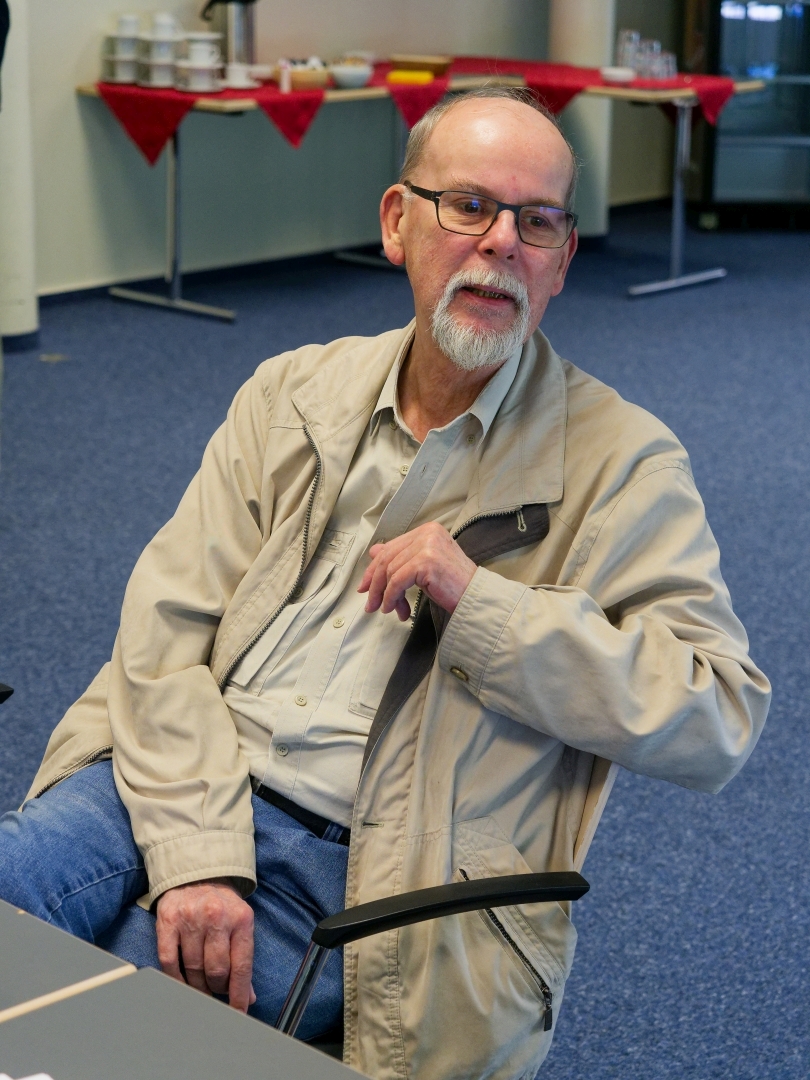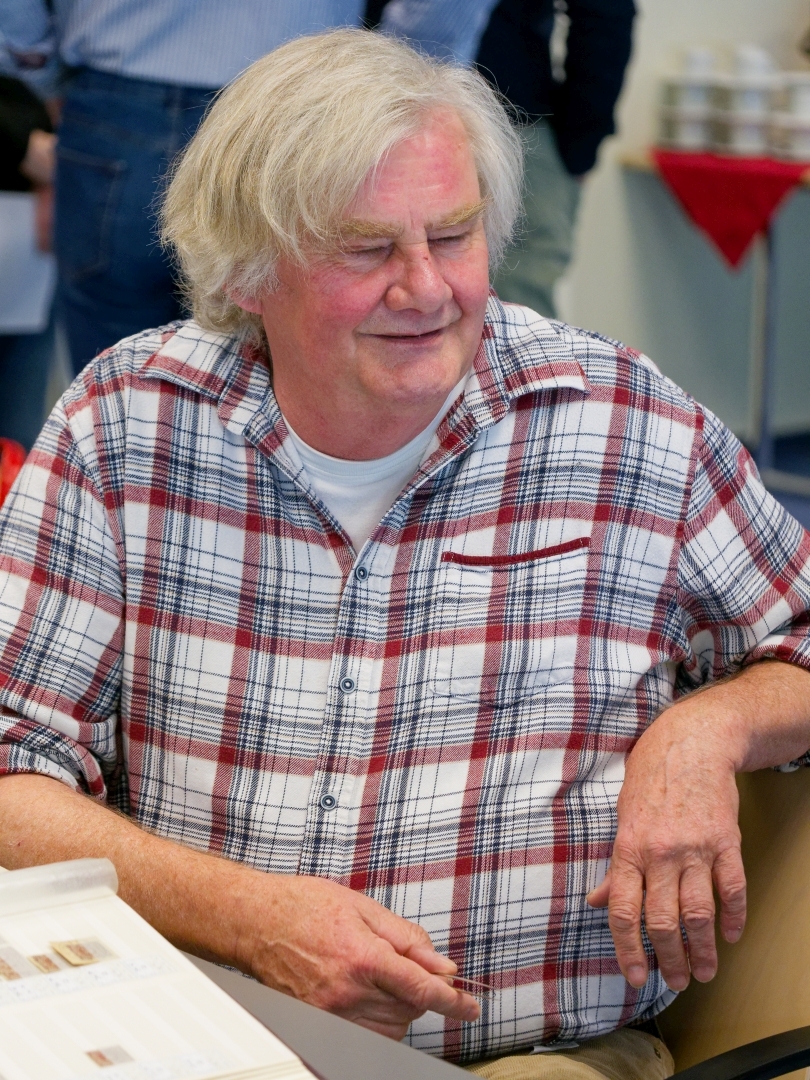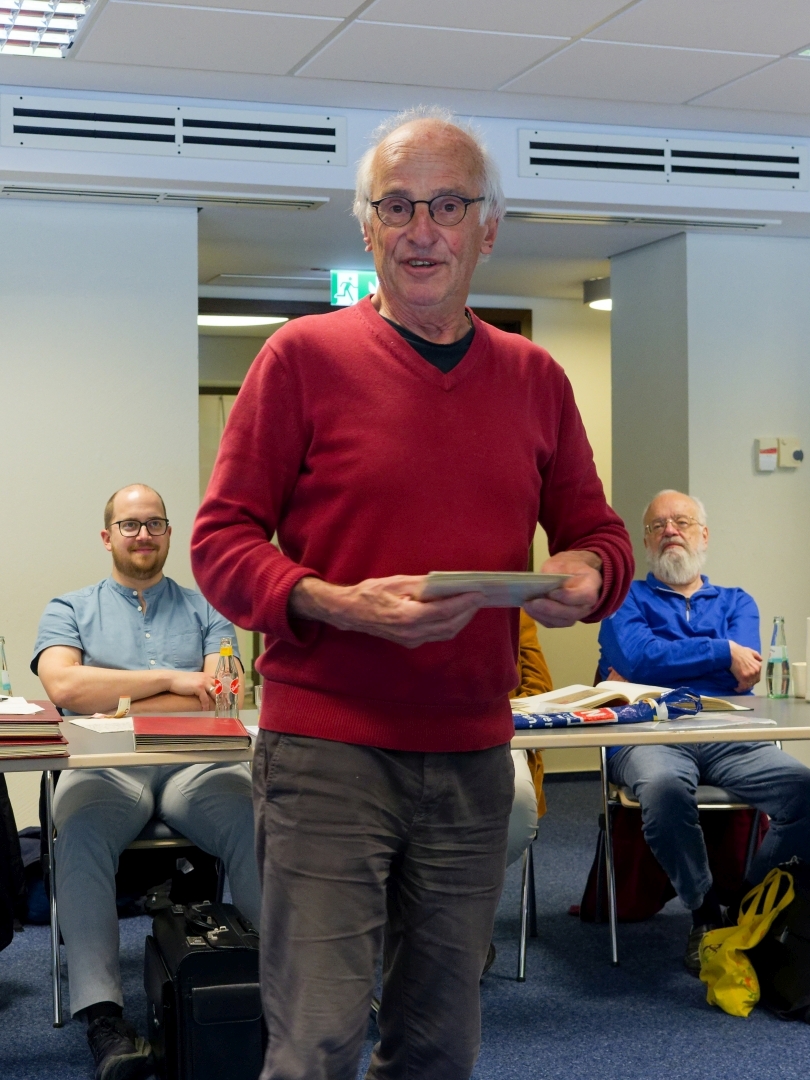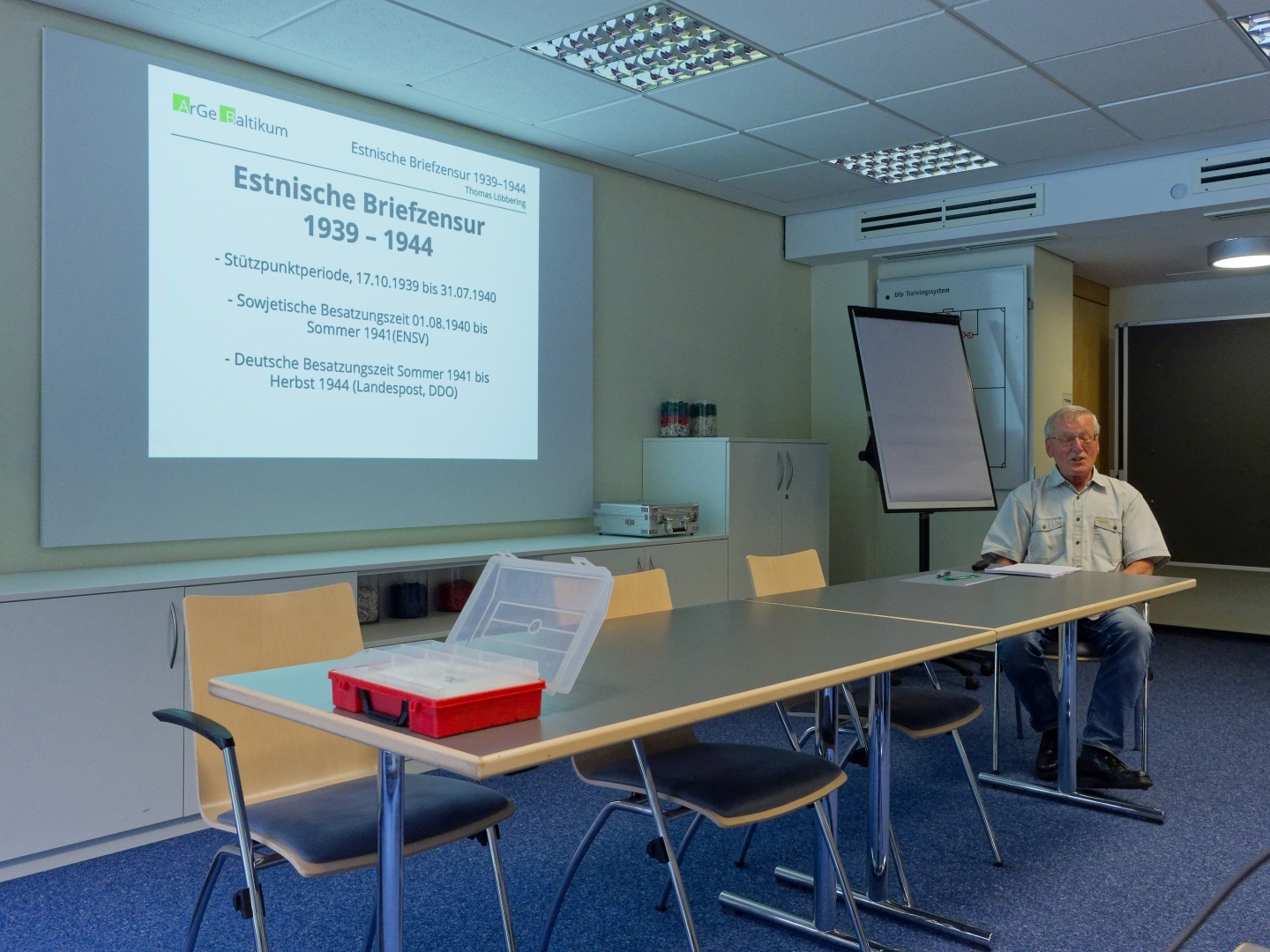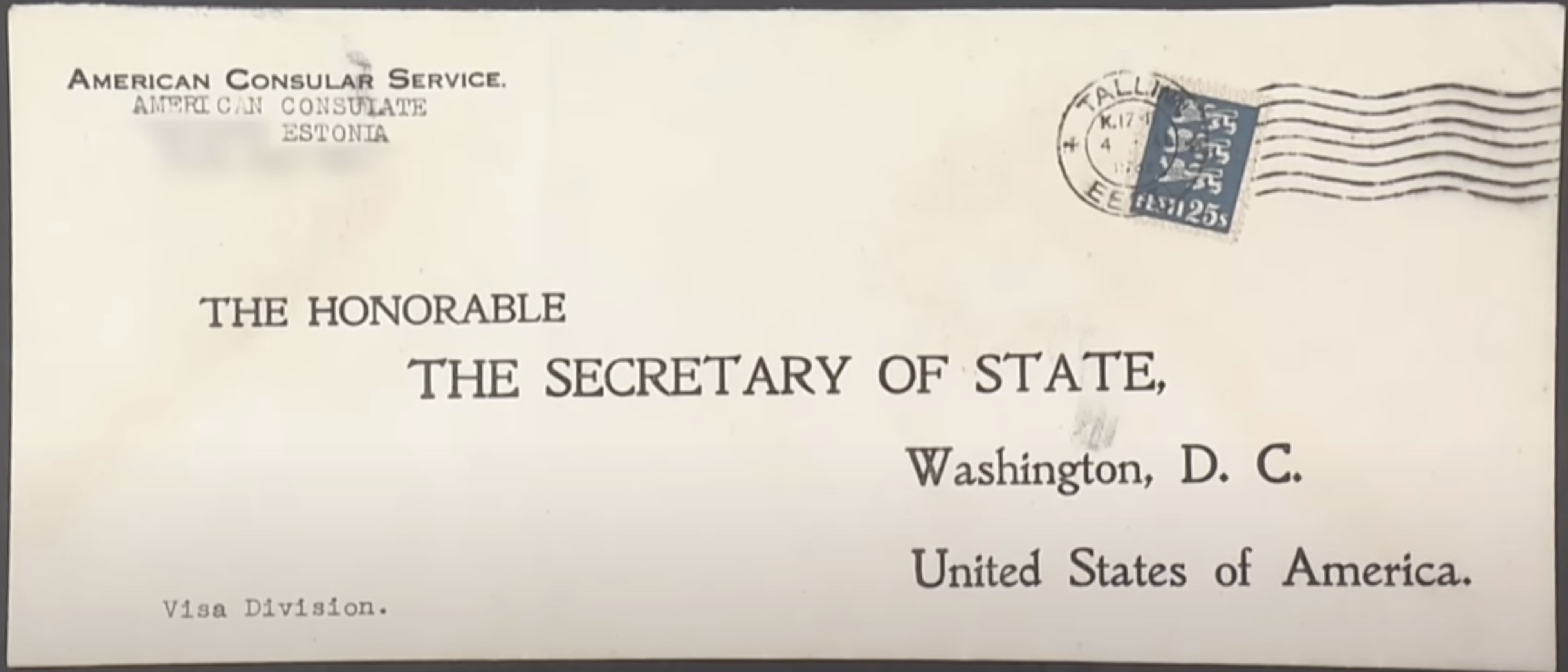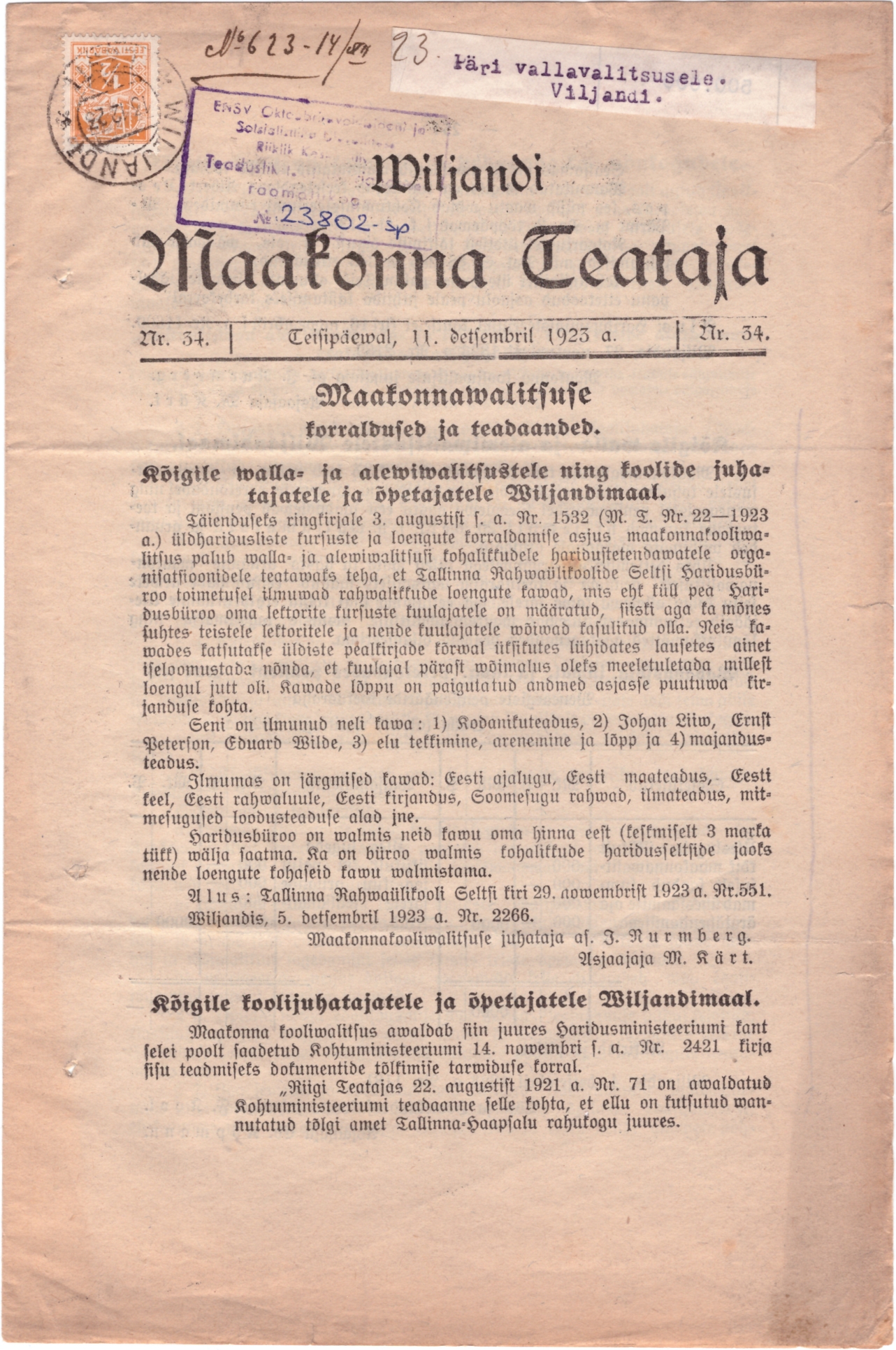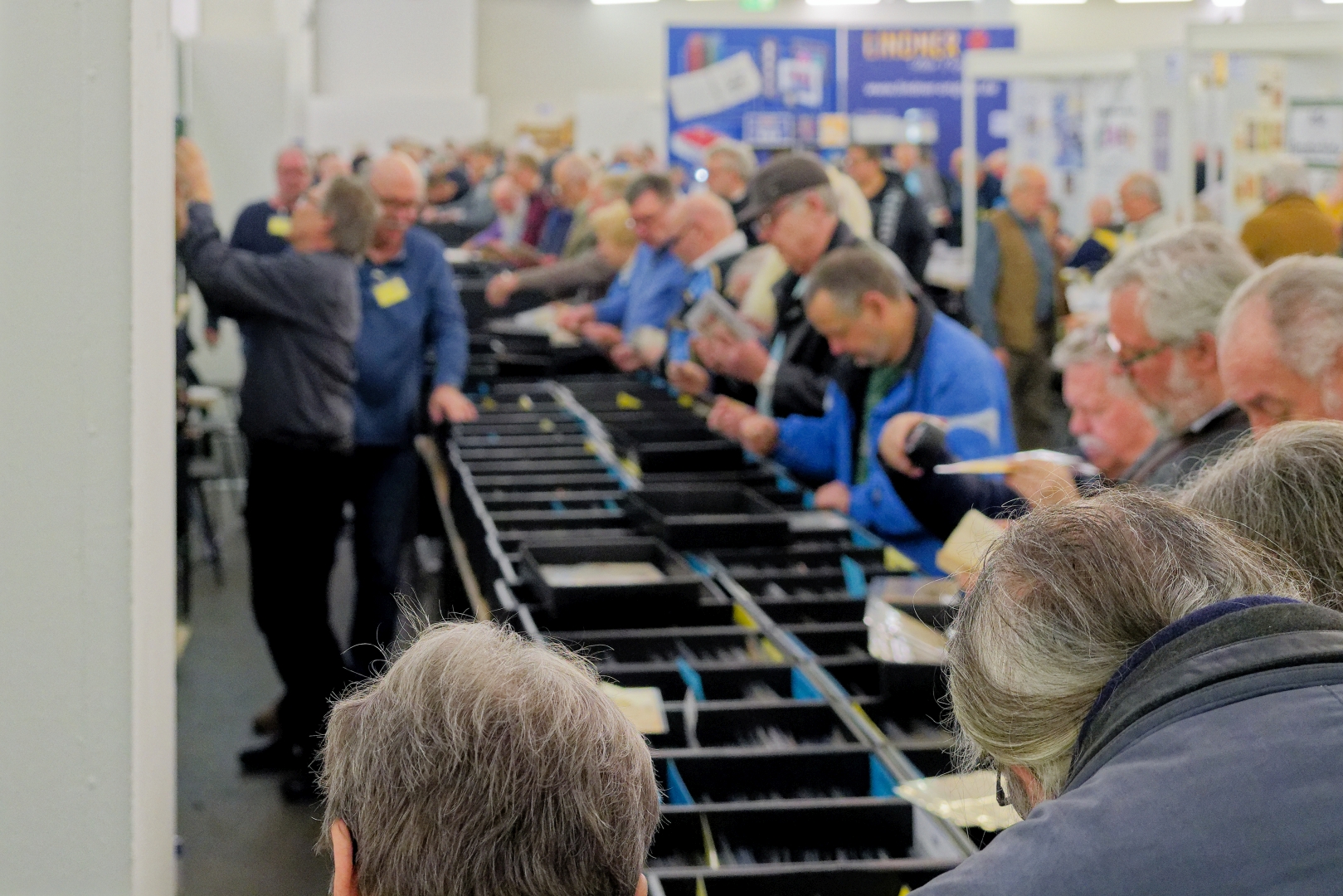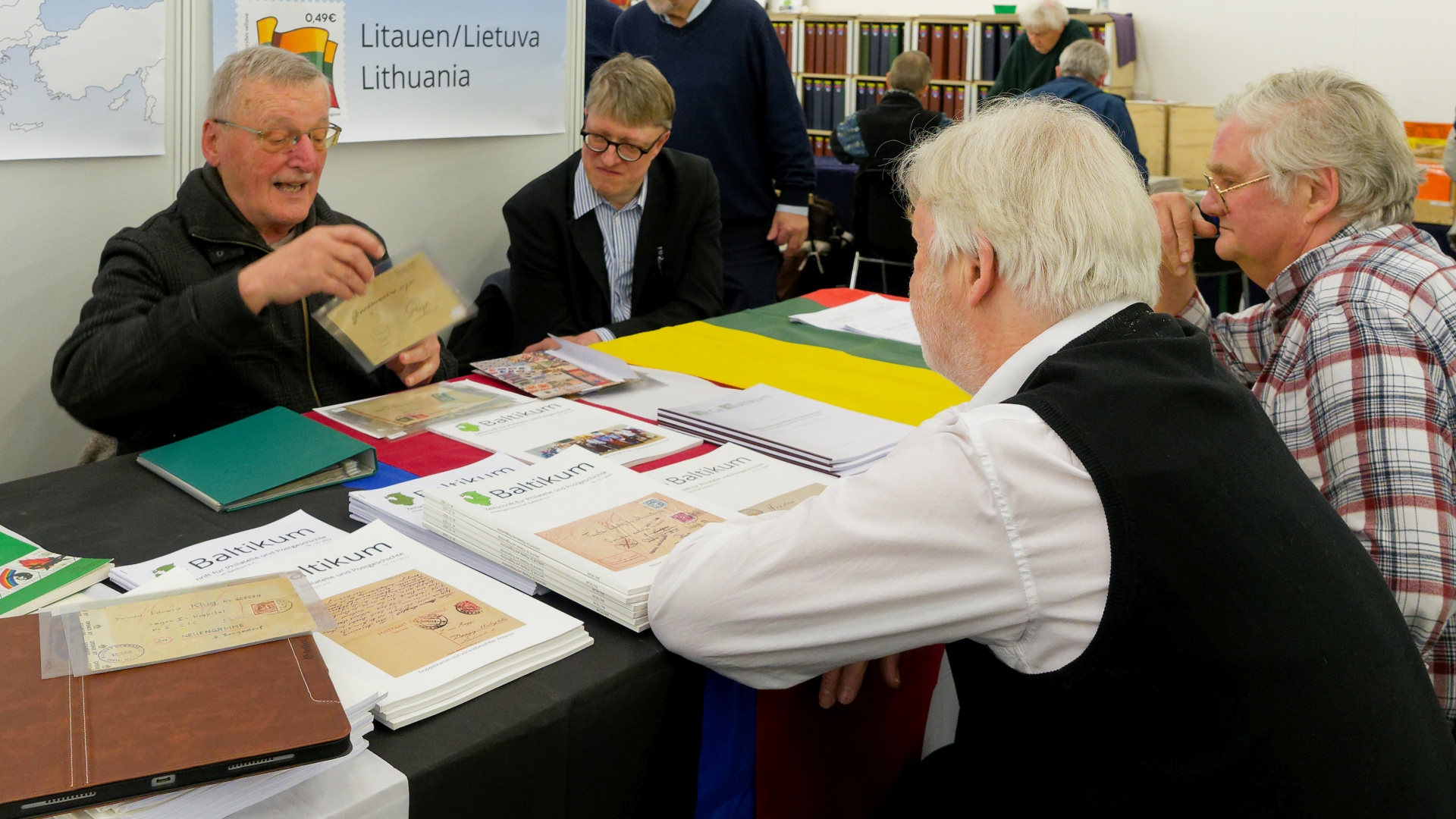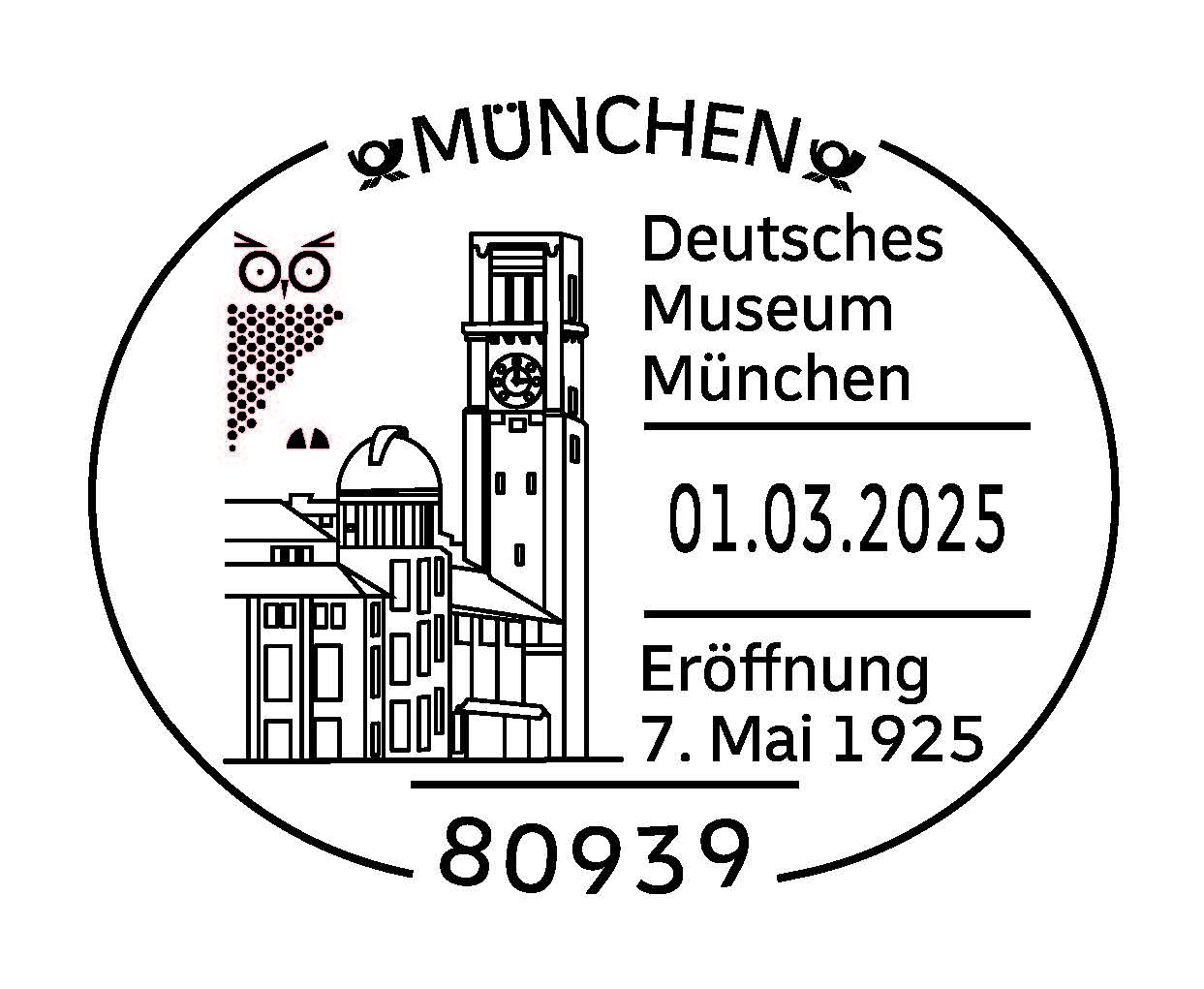53. monthly video chat
There were two main topics in this video conference:
Friedhelm Doell presented his latest acquisitions at DP-Post, this time with a parcel shipment from DP camp to DP camp and a light airmail letter from a DP camp to Australia.
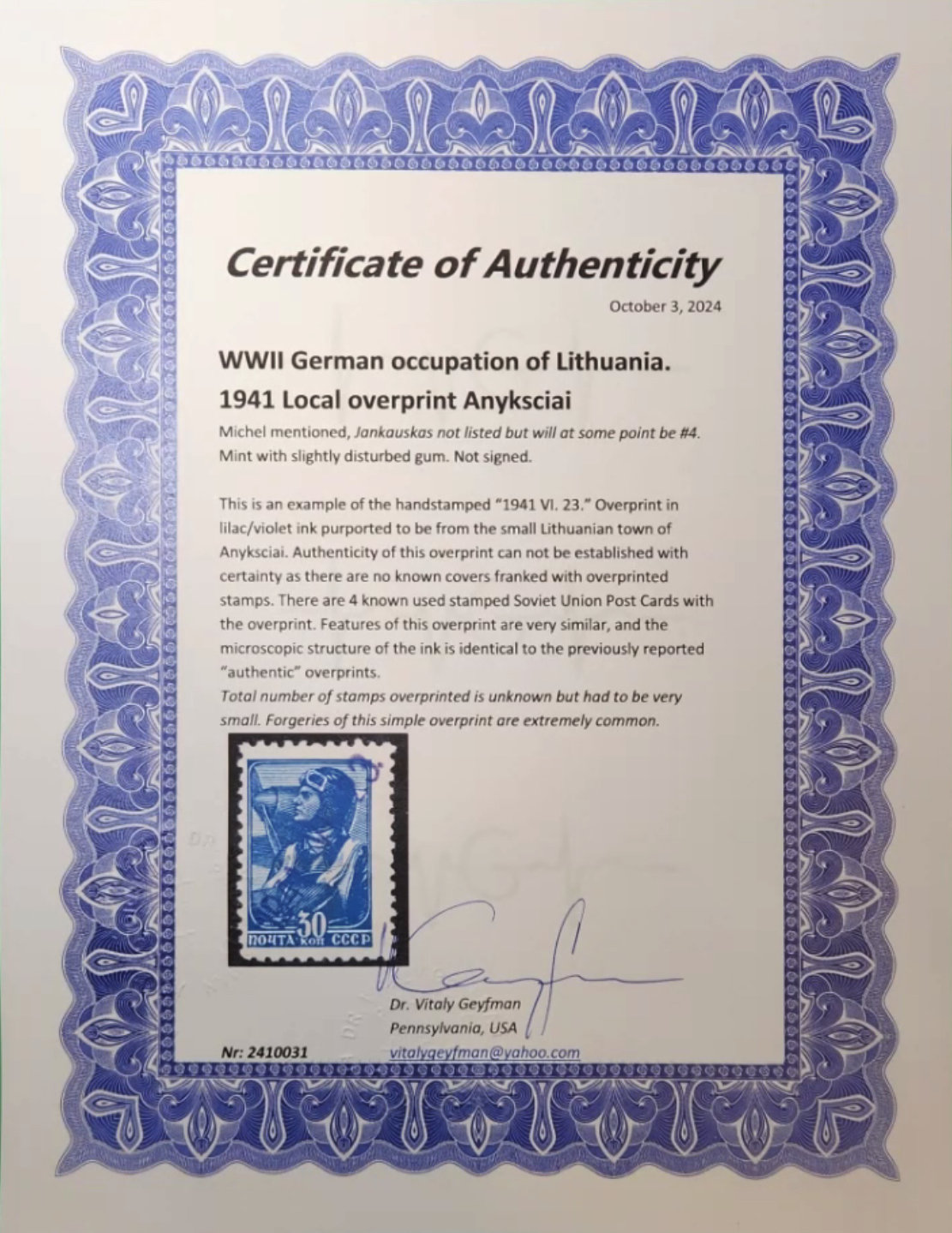
Vitaly Geyfman presented newly discovered overprints from the small town of Anykšžiai in Lithuania dated 23 June 1941, which turned the former Soviet stamps into Lithuanian local issues.
This happened one day after the German Reich attacked the Soviet Union and one day before Vilnius and Kaunas were captured – German troops had not yet reached Anykšžiai, but these stamps already declared the joy of a hoped-for liberation from the Soviet occupiers (not knowing that one occupying power would simply be replaced by another).
The 30 kopeck blue overprint stamp (see certificate) was previously only known on used postcards, but is now available for the first time as a single stamp with exactly the same characteristics (however, there are plenty of forgeries of this!).

Also new are overprints from Anykšžiai on 5 kopeck red and 20 kopeck green stamps.
Our monthly video chat, where anyone with an interest in Baltium philately is welcome, takes place on every first Saturday of the month at 17 h CET more technical information on this here).
Next date: October 4, 2025
Special theme: none so far This email address is being protected from spambots. JavaScript must be activated in order for it to be displayed.
Join the Zoom meeting with:
https://us02web.zoom.us/j/85338222428?pwd=WGpZRXJTZVpnSnB6eHg4Ukx2aFVHdz09
52. monthly video chat
Following a successful test reprint of BALTIKUM 18 at SAXOPRINT, it was jointly decided to use 115 g/m2 paper and 300 g/m2 cover, both matt, for future printing of BALTIKUM from issue 19 onwards (which fully meets expectations).

Olaf Hoffmann showed some of his latest acquisitions, including a postcard from the shipping company J. Dicks & Co. Ltd. in Pernau (now Pärnu, Estonia) dated May 28, 1886, via Riga May 30 (both cities were part of the Russian Empire at the time) to Copenhagen June 14, 1886, with arrival stamp K OMB.2.
From Jaan Roots, we saw an Estonian money order for 26,000 marks with 280 marks postage and – very rarely – a telegraphic money order sent within Estonia.
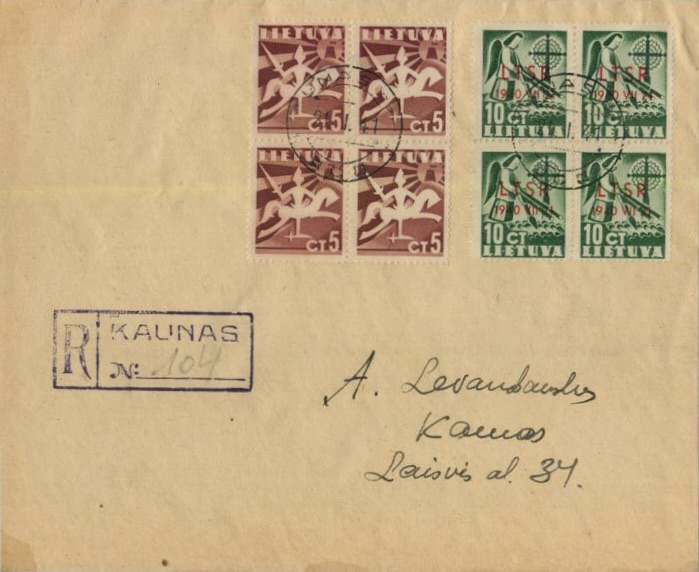
Martin Bechstedt warned against forgeries with Lithuanian daily postmarks prior to 1945, which also exist with unissued stamps.
In this example, one would expect to see a (genuine) letterpress impression with crushed edges, but what can be seen is a well-known counterfeit Kaunas c postmark with raised toner, presumably applied with a zinc stamp. The Kaunas R postmark is also counterfeit; in this case, the stamps are genuine.
Further forgeries bearing the well-known Kaunas-Viljampole a counterfeit postmark were also displayed.
Our monthly video chat, where anyone with an interest in Baltium philately is welcome, takes place on every first Saturday of the month at 17 h CET more technical information on this here).
Next date: September 6, 2025
Special theme: none so far This email address is being protected from spambots. JavaScript must be activated in order for it to be displayed.
Join the Zoom meeting with:
https://us02web.zoom.us/j/85338222428?pwd=WGpZRXJTZVpnSnB6eHg4Ukx2aFVHdz09
51. monthly video chat
Friedhelm Doell and Olaf Hoffmann presented new acquisitions: DP Camp Post 1945–1947 and letters with perforated strips from Tartu 1992.
Friedhelm could hardly believe what an adventure it was to prepare the reprint of BALTIKUM 18 at a new printing company with the technical requirements there. In the end, a real pre-press was produced – without professional design software, using only on-board tools such as MS Word and Adobe Acrobat.
We can report on a small celebration in Munich, where Olaf Hoffmann was retrospectively awarded his BDPh badge of honour – in a worldpremier, as the first graphic designer to receive such an honour!
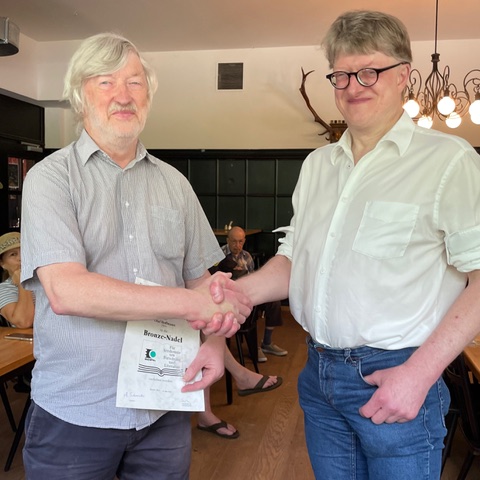

The perforated strip at the top (produced at the Tartu Observatory) was stamped with the red stamp TARTU f 19129100 to become an officially approved postage stamp. However, the postage on the letter was no longer sufficient on March 5,1992: at 5.10 roubles, it corresponded to the postage valid until February 28, 1992 for an airmail letter up to 20g abroad (1.50 roubles) plus registered mail fee (3.60 roubles).
But from March 1, 1992, the postage for a letter weighing up to 20 grams to other European countries was increased to 20 roubles (regardless of whether it was airmail or not) and the registered mail fee to 10 roubles, so the postage would actually have been 30 roubles!
However, this did not bother users and apparently also the postal workers involved: sent from philatelist to philatelist, there were genuine letters with this insufficient postage still in circulation even on March 15, 1992!
Our monthly video chat, where anyone with an interest in Baltium philately is welcome, takes place on every first Saturday of the month at 17 h CET more technical information on this here).
Next date: August 2, 2025
Special theme: none so far This email address is being protected from spambots. JavaScript must be activated in order for it to be displayed.
Join the Zoom meeting with:
https://us02web.zoom.us/j/85338222428?pwd=WGpZRXJTZVpnSnB6eHg4Ukx2aFVHdz09
50. monthly video chat
At this anniversary get-together, the first topic of discussion was the upcoming issue of BALTIKUM No. 19/2025 – its contents and what we would have to postpone until the next issue. That's because we had significantly more contributions than we can fit into a normal issue.
A particular highlight of this issue is the document shown here, which will also appear on the front cover and accompanies the main article "Dorpat (Tartu) 1941 – The 'Landespost' (national post) and 'Wiederaufbau' (reconstruction) postage stamps" by Thomas Löbbering.
Another topic was obtaining stamps in Lithuania. A collector there had small cardboard cards made (size approx. 6×6 cm) on which he asks for stamps at post offices. It looks like this:
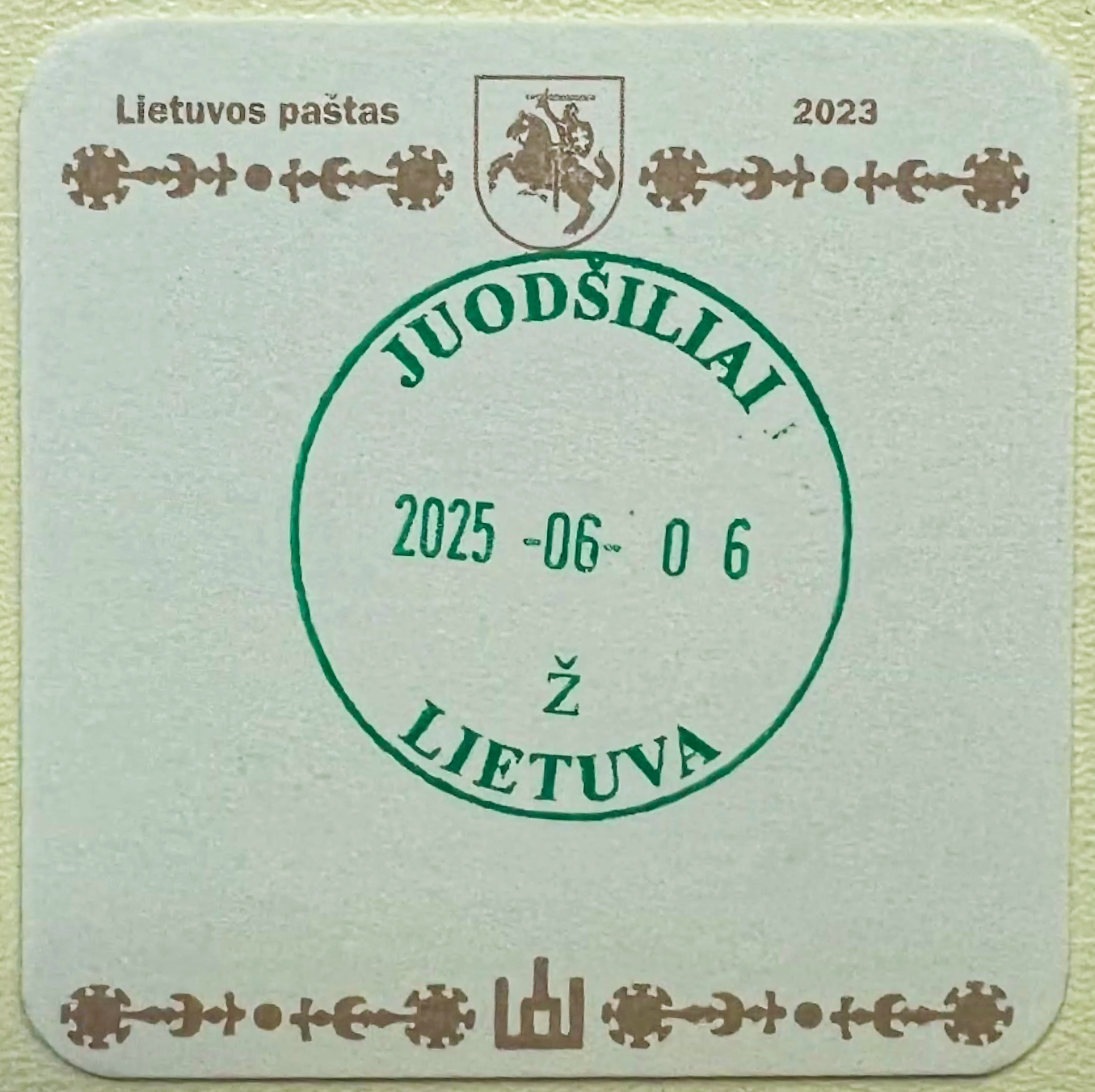
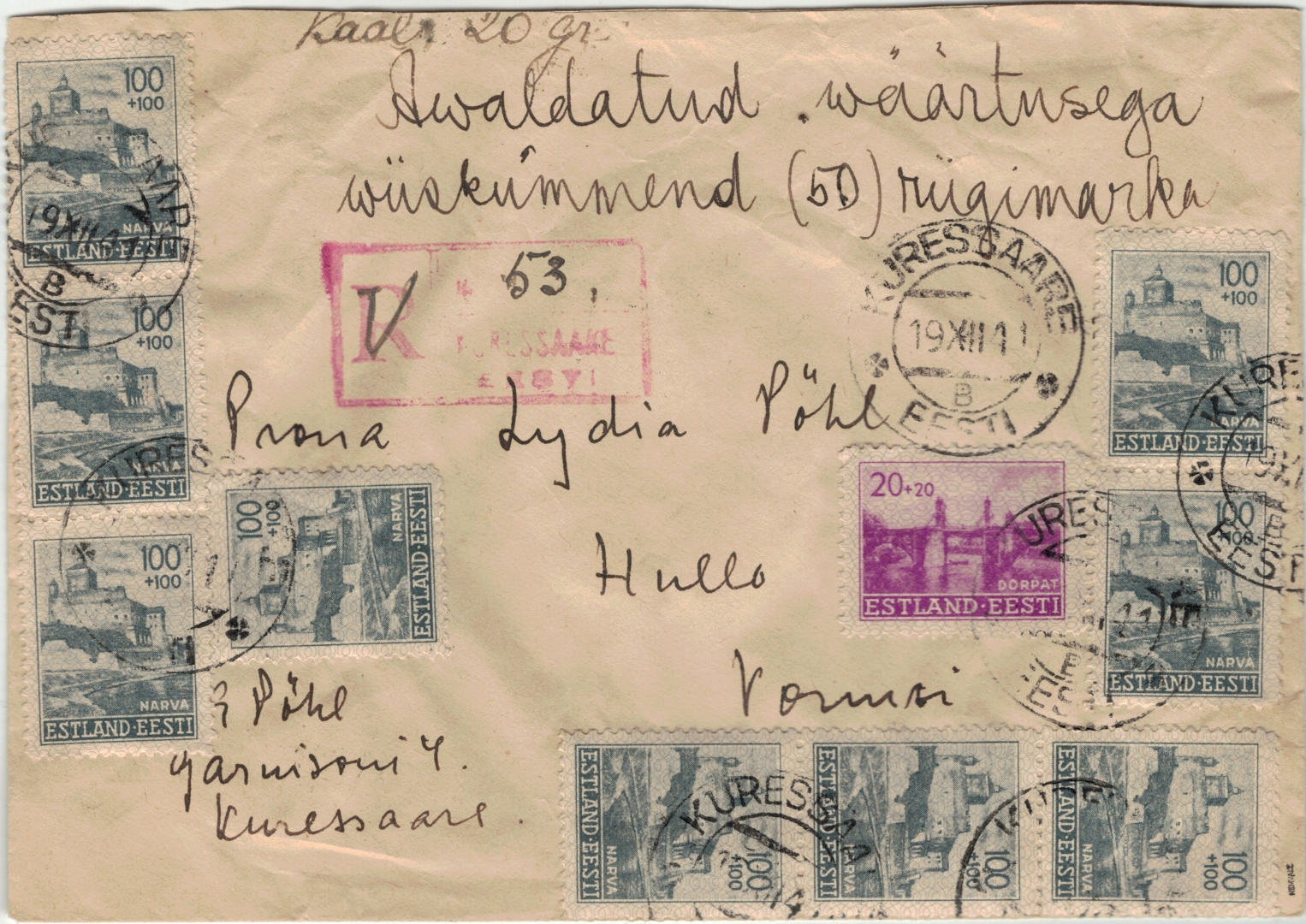
Mixed postage German occupation of Estonia MiNr. 5 and 9 (9), postage rates 12+30+40+10 = 92 pfennigs or 920 kopecks for the registered letter over 50 Reichsmarks
A piece of mail that is highly interesting from both a historical and philatelic perspective: a registered letter weighing 20 grams and worth 50 Reichsmarks, sent by the Estonian national postal service from Kuressaare B, Hurt / Ojaste 244:6, on December 19, 1941, to Hullo on Vormsi. The V-label of the DDO based on the German model for Kuressaare / Arensburg on Ösel is only documented from 1942 onwards. However, the Estonian national postal service obviously did not have a V-label or V-stamp based on the Estonian standard either. Instead, it used the new Soviet Estonian R stamp "R No. KURESSAARE ENSV", provisionally converted into a V stamp by overwriting the "R" with a "V" for Valeur. According to the regulations, "actually" no monetary letter was permitted for Estonian civil traffic, only registered items. The reality contradicts the official records.
Our monthly video chat, where anyone with an interest in Baltium philately is welcome, takes place on every first Saturday of the month at 17 h CET more technical information on this here).
Next date: July 5, 2025
Special theme: none so far This email address is being protected from spambots. JavaScript must be activated in order for it to be displayed.
Join the Zoom meeting with:
https://us02web.zoom.us/j/85338222428?pwd=WGpZRXJTZVpnSnB6eHg4Ukx2aFVHdz09
Honouring Friedhelm Doell, Thomas Löbbering & Olaf Hoffmann
Three members of our working group were honoured with certificates and pins by the German Philatelists' Association (BDPh) at its 2025 general meeting in Hennef for their "services to research and literature". The awards were presented on behalf of the BDPh by ArGe chairman Torsten Berndt.
For first-time honours, the BDPh awards a bronze medal, and for a second honour, a silver medal.
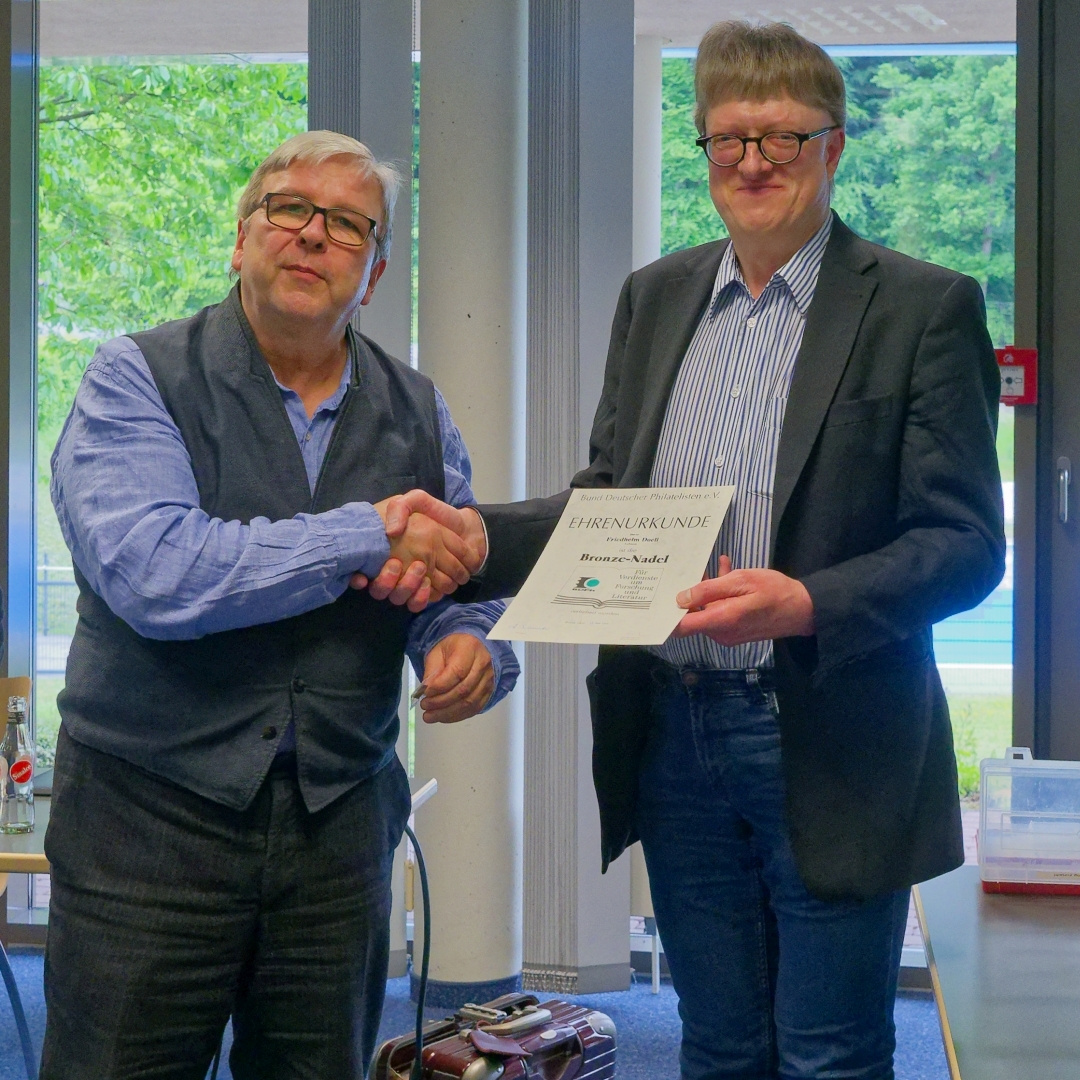
Bronze certificate of honour for Friedhelm Doell
Friedhelm Doell is corporate designer and webmaster for ArGe, editorial designer for BALTIKUM and online host for the monthly video conferences. These activities are indispensable for ArGe's public relations work.
The board and members of ArGe congratulated the honourees on their recognition by the national philatelists' association BDPh for their commitment to ArGe in strengthening philately of the Baltic region.
AGM 2025 was held again in Hennef
The state sports school in Hennef was and remains the ideal location for our annual general meeting – relatively easy to reach, fantastic food, a quiet room for us, and everything at very reasonable prices!

The barbecue on Saturday evening took place indoors this time so that no one would catch a cold in the cold drizzle.
The results of the formal part can be read by members of the ArGe in BALTIKUM No. 19. Suffice it to say that the new board is the old board, there were several honours (see separate article) and much more.
As always, specialist presentations enriched the afternoon:
Experience shows that, as nice as it is to see each other online every month, there is no substitute for meeting in person, exchanging ideas and directly assessing stamps and covers!
49. monthly video chat
Jaan Roots showed 2 very rare covers from Estonia during the time of the withdrawal of German troops of the Commander-in-Chief East ("Ob. Ost") in November 1918 with handwritten note "Eesti", affixed in Riga (see illustration on the right).
Friedhelm Doell showed a presumably unique document from the day the Polish DP camp in Haren / Ems was founded, which changed its name to Mazkow for several years.
Martin Bechstedt revealed the secret of the Lithuanian Post's green cancellations: they are used for domestic simple letters, while domestic registered letters and all international mail receive black cancellations. The green postmarks can be easily distinguished from the larger decorative Christmas postmarks with a rapidly oxidising green postmark ink.
Finally, Michael Wieneke and Friedhelm Doell showed Zeppelin feeder mail and catapult mail from Estonia to America, including a rare cover of the steamer "Europa" (most catapult flights were made from the steamer "Bremen").
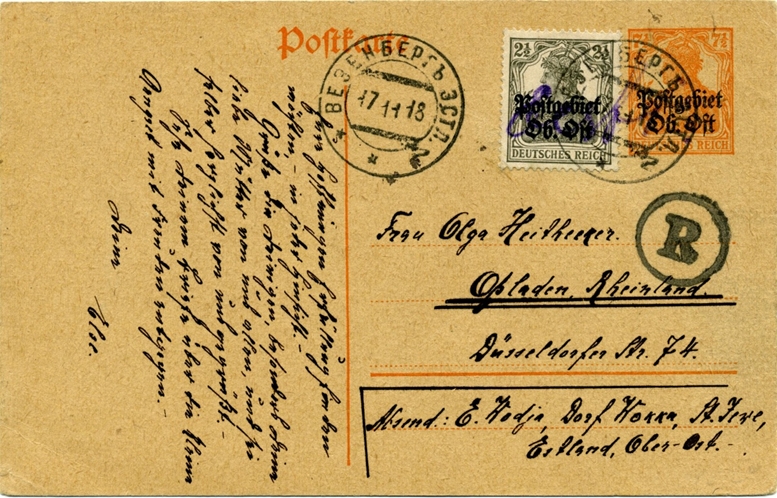
This cover from Wesenberg (Estonian: Rakvere) / Estonia to Opladen / Germany dated November 17, 1918 was issued at a time when the German troops of the "Oberbefehls-haber (Ob.) Ost" were just withdrawing from Estonia, but the new Estonian republic did not yet have its own stamps and postmarks (the postmark dates from the Russian period). The card was transported by Ober-Ost post to Riga and labelled "Eesti" by hand by the postmaster there to indicate to other postal authorities in the event of a possible return that it did not have to be sent to Ob. Ost, but to Estonia.
Our monthly video chat, where anyone with an interest in Baltium philately is welcome, takes place on every first Saturday of the month at 17 h CET more technical information on this here).
Next date: June 7, 2025
Special theme: none so far This email address is being protected from spambots. JavaScript must be activated in order for it to be displayed.
Join the Zoom meeting with:
https://us02web.zoom.us/j/85338222428?pwd=WGpZRXJTZVpnSnB6eHg4Ukx2aFVHdz09
48. monthly video chat
Martin Bechstedt presented the explanatory cards that have been sent with subscriptions to new stamps from the Estonian Post since 2003, and which are currently being sent to Germany in two languages, German and French. There is currently a 3rd series of the new Estonian coat-of-arms stamps, which includes not only a €10 stamp but also a 1 €–stamp in the format 34 x 43 mm (!).
Simon Schütt showed some covers from the early 1920s with foreign destinations (see example on right).
Friedhelm Doell is currently looking for covers from or to Displaced Persons Camps in Germany 1945-1949 in the French occupied zone (‘ postage paid’ or franked) and was able to pick up some tips for further contacts, e.g. to the Working Group French Zone.
Finally, the participants discussed internal ArGe topics.
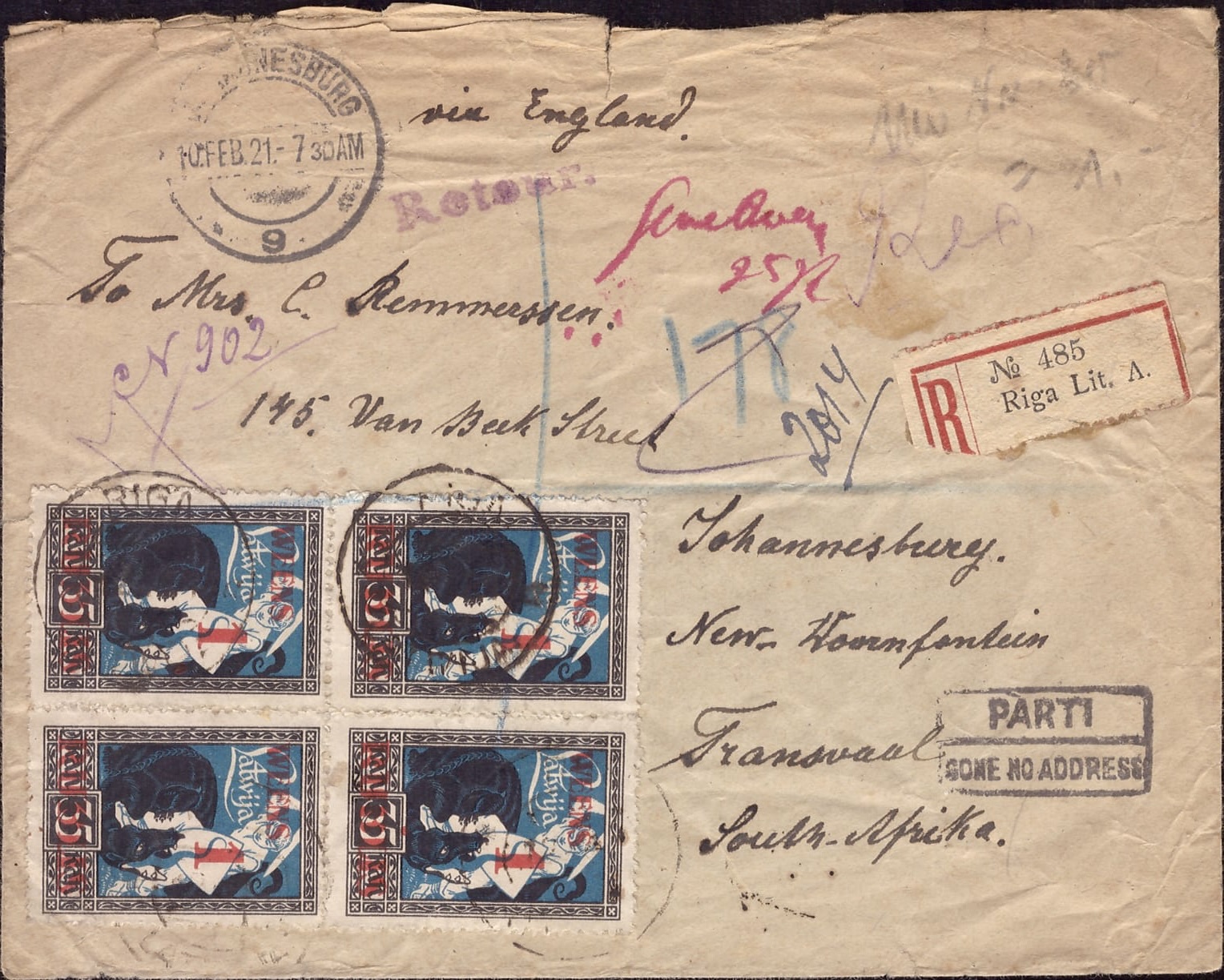
A cover from the period after Latvia's War of Independence, from Riga (date?) to Transvaal / South Africa February 10, 1921, franked with a block of four of the 1 kopeck Dragon Rider overprint stamp of 1920 (Michel No. 60)
Our monthly video chat, where anyone with an interest in Baltium philately is welcome, takes place on every first Saturday of the month at 17 h CET more technical information on this here).
Next date: May 3, 2025
Special theme: none so far This email address is being protected from spambots. JavaScript must be activated in order for it to be displayed.
Join the Zoom meeting with:
https://us02web.zoom.us/j/85338222428?pwd=WGpZRXJTZVpnSnB6eHg4Ukx2aFVHdz09
Estonian philately on Japanese television
A different take on "Social Philately": In this report by the Japanese television station ANN News Channel, stamp collecting is presented as a hobby of our ArGe member Yuki Itabashi.
From minute 2:15, a cover from Estonia to the USA is shown. The franking is rather ordinary (25 senti, issued from 01.04.1935, valid until 31.12.1940), the sender shows the visa department of the American consulate in Tallinn (name blurred), the recipient is the Secretary of State of the United States of America, which was Cordell Hull at the time.
What is social philately about it? This is shown on the back of the envelope, which states in a dealer's acknowledgement that the cover once belonged to the collection of Franklin D. Roosevelt, who was the 32nd President of the USA at the time (Roosevelt was a real stamp collector who is said to have paid 100 US dollars for the cover).

In this case, social philately does not refer to the sender or recipient of a document, but to the provenance, the interim owner of the item.
The fact that a national news programme broadcasts a report on philately as a current hobby with a story behind it is a real gain for our hobby!
46. monthly video chat
The first topic was a report and photos from Philatelia in Munich (see also separate article below) – a now "normal" trade fair stand without any major special features.
Oliver Hanschmidt showed some Estonian newspaper frankings from the year 1923 – local printed matter rate ½ marka – they have never been seen in this form before (see picture).
Olaf Hoffmann introduced us to some new acquisitions from the last few weeks. Many an explanation and additional information on individual pieces was provided by the participants.
Finally, Martin Bechstedt reported on the possibilities of being able to conveniently translate an article in an unknown foreign language (here: Lithuanian) with the software DeepL (in the paid version) on a mobile phone and a photo of the original. His example dealt with an article by the technical manager of the Lithuanian postal service, in which he describes the difficulties of obtaining postmarks in 1994 in view of Lithuanian special requests (e.g. for the date) (see article soon in BALTIKUM).
Our monthly video chat, where anyone with an interest in Baltium philately is welcome, takes place on every first Saturday of the month at 17 h CET more technical information on this here).
Next date: April 5, 2025
Special theme: none so far This email address is being protected from spambots. JavaScript must be activated in order for it to be displayed.
Join the Zoom meeting with:
https://us02web.zoom.us/j/85338222428?pwd=WGpZRXJTZVpnSnB6eHg4Ukx2aFVHdz09
A well-attended exhibition hall
Our trade fair team spent two successful days at the Philatelia trade fair in Munich on the first weekend in March. We had numerous interesting discussions, exchanged ideas with representatives of other associations and, of course, took the opportunity to broaden our horizons and gain inspiration for our collecting areas. On Saturday, the exhibition hall was surprisingly well attended. You have to look back a good decade to remember such a crowd. On Sunday, the number of visitors was lower. It may have been noticeable that the Philatelia took place during the carnival season, perhaps that is why visitors who usually visit the Philatelia on Sundays came on Saturday this time.
As in previous years, Friedhelm Doell, Reinhard Heinrich, Olaf Hoffmann, Thomas Lö0bbering and Torsten Berndt made up our trade fair team. They are a well-practised team and take the opportunity to exchange views on topics that have nothing or only indirectly to do with the trade fair.
The next trade fair date on the calendar is the International Stamp Fair in Ulm on the last weekend in October. We have already registered and will once again set up an information stand. Of course, we are also planning an information stand at Philatelia in Munich next year.
Incidentally, anyone who visited the Deutsche Post stand could get a very special stamp there: It is now one hundred years since the German Museum in Munich was able to open its new building on the River Isar.
To mark the occasion, our member Olaf Hoffmann designed the stamp, which shows the building and the museum's current logo.
46. monthly video chat
Several participants presented pieces mainly from the years between 1918 and 1945, some of which were the subject of intense discussion. A field post letter with the beautiful postmark date 4.4.44, presented by Oliver Hanschmidt, was probably the favourite – only the time did not quite fit, but as they say, you shouldn't quibble. Michael Wieneke was able to determine where the sender was at the time, based on the field post number.
As a sneak preview of things to come, Olaf Hoffmann presented a postmark marking the 100th anniversary of the opening of the German Museum in Munich. Collectors will be able to get their hands on the postmark at the Deutsche Post stand at Philatelia on March 1 and 2.
Incidentally, the philatelic story with the letters of invitation to the general meeting (see the article on the 45th videochat) had a happy ending (as planned) with a double last-day cover: December 31, 2024, marked not only the end of the 85-cent postage rate, but also – at least as things stand – the end of the era of machine stamps in Germany.
Please note: Due to the Philatelia fair, the next regulars' table will not take place until the second Saturday in March, i.e. on March 8 at 17 h CET. The other dates throughout the year remain unchanged – always the first Saturday of the month.
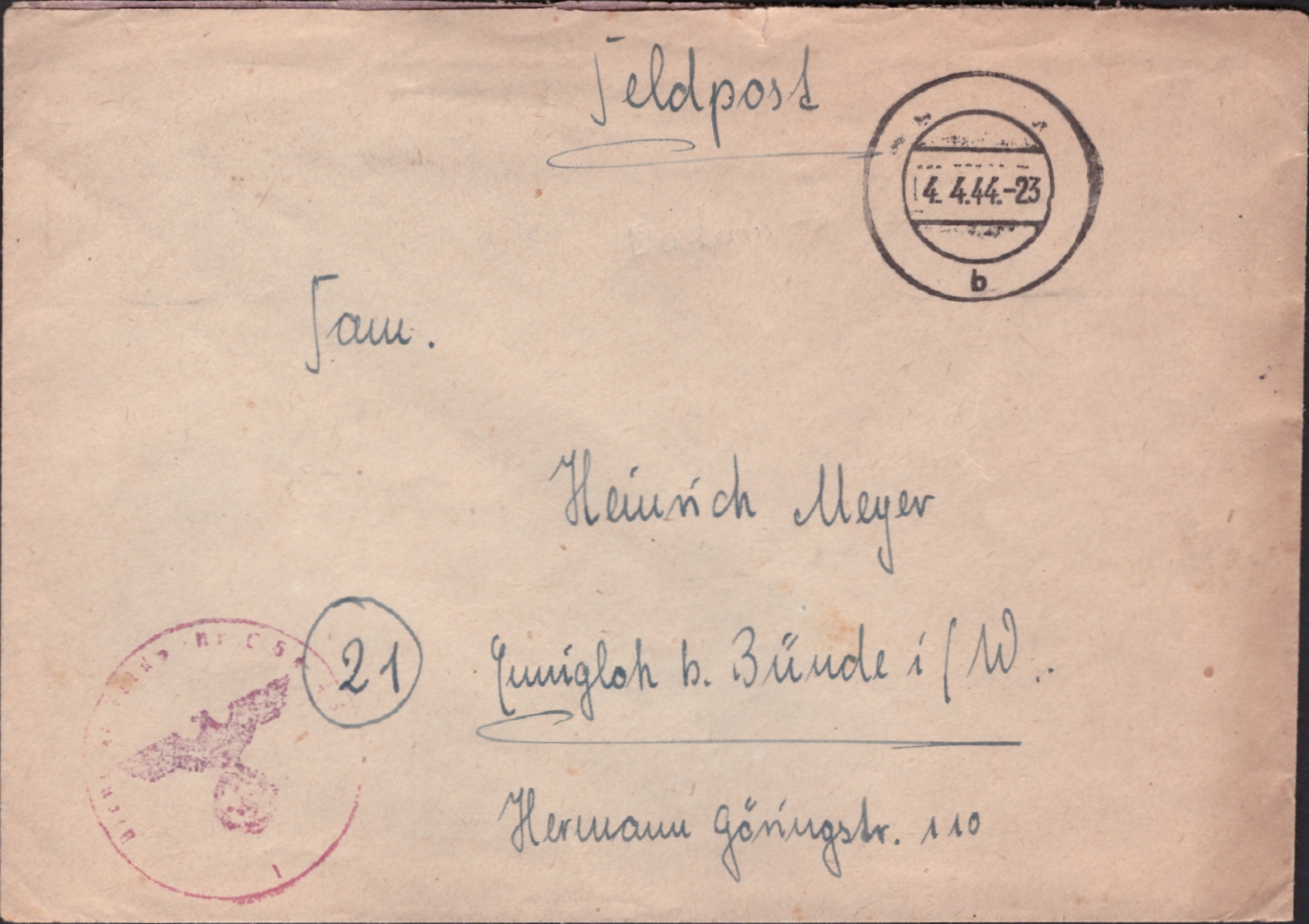
Letter from 4.4.44 – even then, "snake numbers" were already popular with collectors
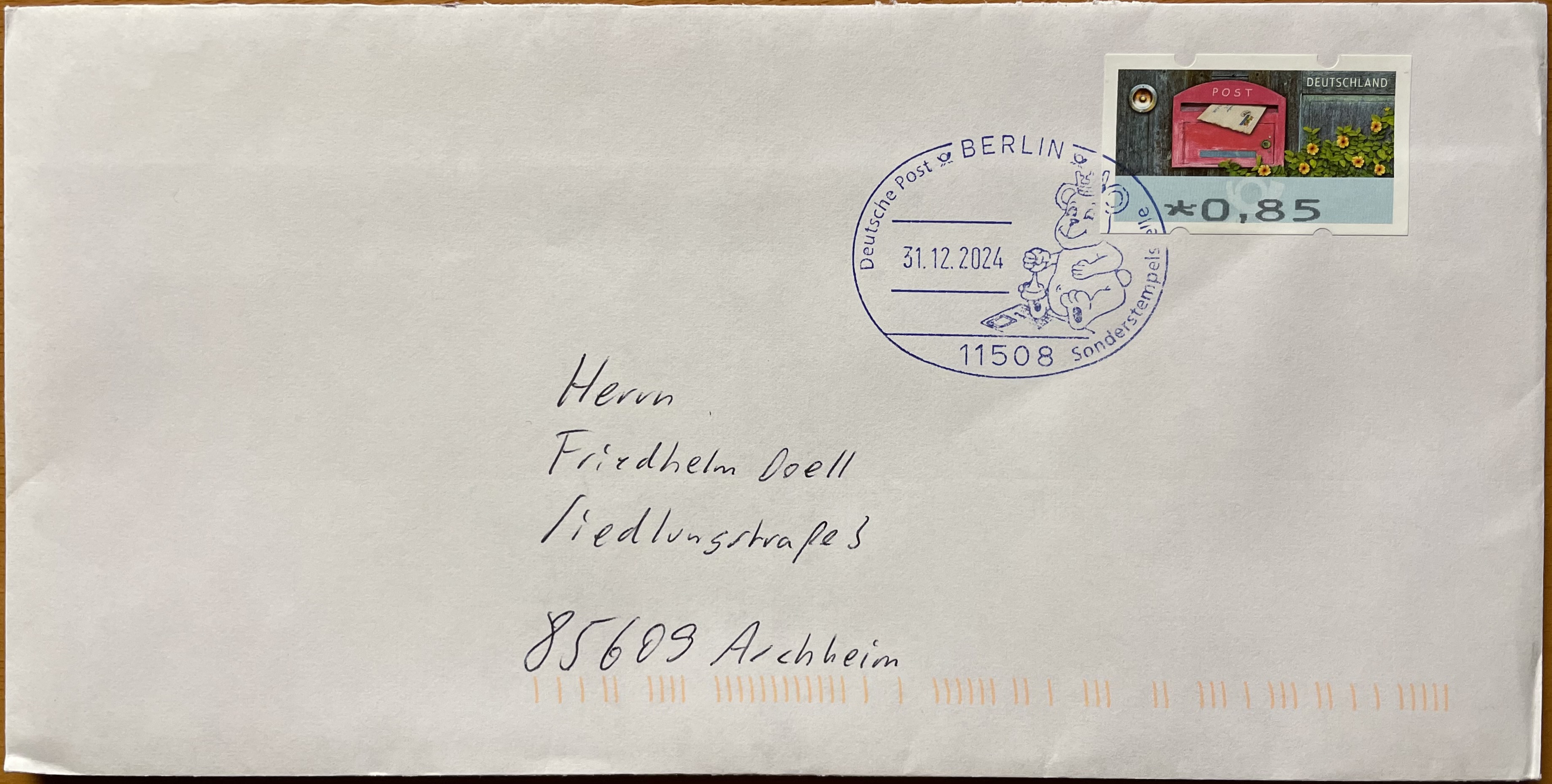
Cover from the last day of domestic postage at 85 cents and also the last day on which vending machine stamps could be obtained throughout Germany – with the special postmark from the Berlin-Tempelhof postmarking office
Our monthly video chat, where anyone with an interest in Baltium philately is welcome, takes normally place on every first Saturday of the month at 17 h CET more technical information on this here).
Next date: exceptionally moved to the 2nd Saturday of the month, March 8, 2025 at 17 h CET due to Philatelia Munich.
Special theme: none so far This email address is being protected from spambots. JavaScript must be activated in order for it to be displayed.
(The other dates in the year will take place on the first Saturday of the month again!)
Join the Zoom meeting with:
https://us02web.zoom.us/j/85338222428?pwd=WGpZRXJTZVpnSnB6eHg4Ukx2aFVHdz09
45. monthly video chat
The presents for the members of the working group ArGe Baltikum on the occasion of the 10th anniversary of the foundation of the group have finally been chosen.
Michael Wienecke and Jaan Roots presented recent acquisitions with special franking and routes from Estonia, some as far as Northern Rhodesia (via Brindisi / Italy). Olaf Hoffmann showed stamps from the 1920 Conference of Baltic Foreign Ministers in Bulduri (German: Bilderlingshof, now a district of Jūrmala) / Latvia, with Thomas Löbbering explaining the history behind them.
Torsten Berndt presented an exciting and still unresolved postal matter, which, however, does not concern a postal institution in the Baltic States, but in Germany: on December 27, 2024, after the Christmas rush, he sent a package of invitations to the to the special postmark office in Berlin, where they were to be cancelled and sent on December 31, 2024, the last day of the 85-cent postage rate for domestic mail and also the last day of use of a certain type of cancellation machine.
However, according to DHL tracking, the package remained in transit for several days and did not reach the special postmark office until January 3, 2025. Questions remain unanswered: will the stamps still be accepted with 85 cents postage (similar to 'from the mailbox')? Will the package be cancelled with the postmark of December 31, 2024 ? Or will it be returned for additional postage? After all, the DHL customer is only entitled to have his item transported, not to have certain deadlines met...
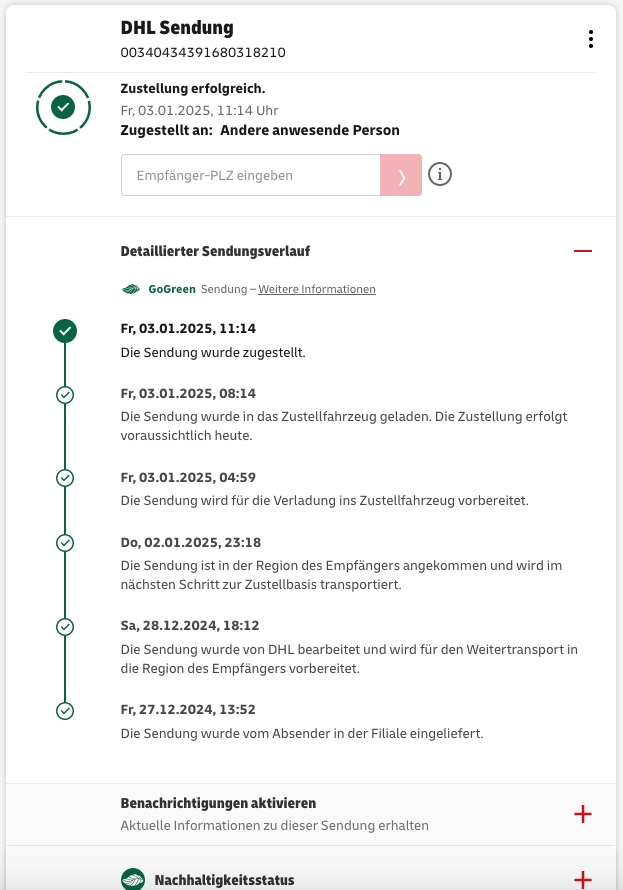
DHL tracking shows that the package (containing the invitations to the general meeting) was left behind the date of the 85-cent postage limit for domestic mail (Dec 31, 2024).
Want to see the solution to the postal delivery thriller live? Then join us for our next video chat!
Our monthly video chat, where anyone with an interest in Baltium philately is welcome, takes place on every first Saturday of the month at 17 h CET (more technical information on this here).
Next date: February 1, 2025
Special theme: none so far (but of course the result of the Berlin odyssey, see text on the left) This email address is being protected from spambots. JavaScript must be activated in order for it to be displayed.
Join the Zoom meeting with:
https://us02web.zoom.us/j/85338222428?pwd=WGpZRXJTZVpnSnB6eHg4Ukx2aFVHdz09



